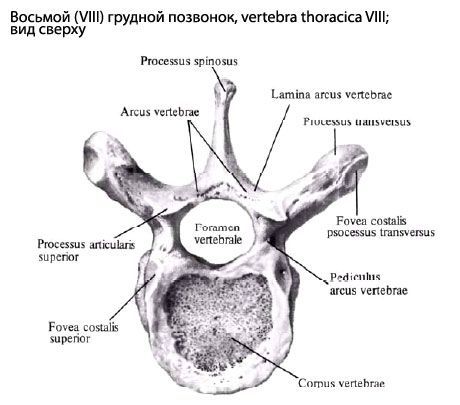Thoracic vertebrae
Last reviewed: 19.11.2021

All iLive content is medically reviewed or fact checked to ensure as much factual accuracy as possible.
We have strict sourcing guidelines and only link to reputable media sites, academic research institutions and, whenever possible, medically peer reviewed studies. Note that the numbers in parentheses ([1], [2], etc.) are clickable links to these studies.
If you feel that any of our content is inaccurate, out-of-date, or otherwise questionable, please select it and press Ctrl + Enter.
The thoracic vertebrae (vertebrae thoracicae) are larger than the cervical vertebrae. The height of their body grows from top to bottom. It is maximal in the XII thoracic vertebra. The spinous processes of the thoracic vertebrae are long, inclined downwards and superimposed on each other. This arrangement prevents the spinal cord from re-opening. The articular processes of the thoracic vertebrae are oriented in the frontal plane, while the upper articular surfaces are directed laterally and posteriorly, and the lower joints are medially and anteriorly.
The thoracic vertebrae (from II to IX) on the posterolateral surfaces of the body have the upper and lower costal fossae (foveae costales superior et inferior), more precisely the half-vessels. The upper half-jamming of the underlying vertebra is combined with the lower half-plane lying above the vertebra and forms an articular surface for the head of the corresponding rib.
Thoracic vertebrae I, X, XI and XII have features. On the body of the first thoracic vertebra there are upper full fossae for articulation with the heads of the first ribs, as well as the lower half-planes, which together with the upper half-legs of the II thoracic vertebra form complete pits for the heads of the second ribs. Thoracic XI and XII vertebrae have full fossae for the corresponding ribs.

The transverse processes of the thoracic vertebrae are thickened at the ends. On the anterior surface of the transverse processes, fossae are visible (foveae costal is processus transversi) for articulation with the tubercle of the corresponding rib. The vertebrae XI and XII do not have pits on the transverse processes.
Where does it hurt?
What do need to examine?
How to examine?

